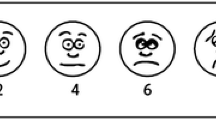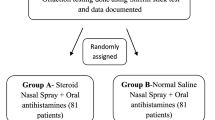Abstract
Systemic treatment with corticosteroids shows therapeutic effects, few patients benefit from intranasal topical drug application, probably due to limited access of the drug to the olfactory epithelium. The aim of the present study was to investigate how drops distribute within the nasal cavity when the “Kaiteki” position is performed. Thirteen healthy volunteers participated. Subjects were lying on the side with the head tilted and the chin turned upward. Blue liquid was used to visualize the intranasal distribution of the nasal drops. The investigation was carried out using photo documentation thorough nasal endoscopy; the intranasal distribution of the dye was judged by two independent observers in both a decongested state and a natural state where no decongestants had been used. With regard to the main criterion of this study, using the “Kaiteki” position, nasal drops reached the olfactory cleft in 96 % of the decongested cases and 75 % of the cases who had not been decongested. However, this difference was not statistically different. Because the “Kaiteki” maneuver is not too difficult to perform, it is more likely that topical steroids can be helpful in cases of olfactory loss.



Similar content being viewed by others
References
Landis BN, Konnerth CG, Hummel T (2004) A study on the frequency of olfactory dysfunction. Laryngoscope 114:1764–1769
Brämerson A, Johansson L, Ek L, Nordin S, Bende M (2004) Prevalence of olfactory dysfunction: the Skövde population-based study. Laryngoscope 114:733–737
Murphy C, Schubert CR, Cruickshanks KJ, Klein BE, Klein R, Nondahl DM (2002) Prevalence of olfactory impairment in older adults. JAMA 288:2307–2312
Damm M, Temmel A, Welge-Lüssen A, Eckel HE, Kreft MP, Klussmann JP, Gudziol H, Hüttenbrink KB, Hummel T (2004) Epidemiologie und Therapie von Riechstörungen in Deutschland. Österreich und der Schweiz. HNO 52:112–120
Heilmann S, Hüttenbrink KB, Hummel T (2004) Local and systemic administration of corticosteroids in the treatment of olfactory loss. Am J Rhinol 18:29–33
Scheibe M, Bethge C, Witt M, Hummel T (2008) Intranasal administration of drugs. Arch Otorhinolaryngol Head Neck Surg 134:643–646
Lam K, Tan BK, Lavin JM, Meen E, Conley DB (2013) Comparison of nasal sprays and irrigations in the delivery of topical agents to the olfactory mucosa. Laryngoscope 123:2950–2957
Miyazaki J, Matsushita H, Yamada S, Inokuchi A (2004) New method for effective instillation of nasal drops in patients with olfactory dysfunction. Pract Oto-Rhino-Laryngol 97:697–705
Kubba H, Spinou E, Robertson A (2000) The effect of head position on the distribution of drops within the nose. Am J Rhinol 14:83–86
Benninger MS, Hadley JA, Osguthorpe JD, Marple BF, Leopold DA, Derebery MJ, Hannley M (2004) Techniques of intranasal steroid use. Otolaryngol Head Neck Surg 130:5–24
Shu CH, Lee PL, Shiao AS, Chen KT, Lan MY (2012) Topical corticosteroid applied with a squirt system being more effective than with nasal spray for steroid-dependent olfactory impairment. Laryngoscope 122:747–750
Blomqvist EH, Lundblad L, Bergstedt H, Stjarne P (2003) Placebo-controlled, randomized, double-blind study evaluating the efficacy of fluticasone propionate nasal spray for the treatment of patients with hyposmia/anosmia. Acta Otolaryngol 123:862–868
Klimek L, Hummel T, Moll B, Kobal G, Mann WJ (1998) Lateralized and bilateral olfactory function in patients with chronic sinusitis compared with healthy control subjects. Laryngoscope 108:111–114
Kayarkar R, Clifton NJ, Woolford TJ (2002) An evaluation of the best head position for instillation of steroid nose drops. Clin Otolaryngol Allied Sci 27:18–21
Karagama YG, Lancaster JL, Karkanevatos A, O’Sullivan G (2001) Delivery of nasal drops to the middle meatus: which is the best head position? Rhinology 39:226–229
Wolfensberger M, Hummel T (2002) Anti-inflammatory and surgical therapy of olfactory disorders related to sino-nasal disease. Chem Senses 27:617–622
Pade J, Hummel T (2008) Olfactory function following nasal surgery. Laryngoscope 118:1260–1264
Vandenhende-Szymanski C, Hochet B, Chevalier D, Mortuaire G (2015) Olfactory cleft opacity and CT score are predictive factors of smell recovery after surgery in nasal polyposis. Rhinology 53:29–34
Acknowledgments
This study did not receive any external support. None of the authors have a conflict of interest. All authors had full access to all the data in the study and take responsibility for the integrity of the data and the accuracy of the data analysis.
Author information
Authors and Affiliations
Corresponding author
Rights and permissions
About this article
Cite this article
Mori, E., Merkonidis, C., Cuevas, M. et al. The administration of nasal drops in the “Kaiteki” position allows for delivery of the drug to the olfactory cleft: a pilot study in healthy subjects. Eur Arch Otorhinolaryngol 273, 939–943 (2016). https://doi.org/10.1007/s00405-015-3701-y
Received:
Accepted:
Published:
Issue Date:
DOI: https://doi.org/10.1007/s00405-015-3701-y




